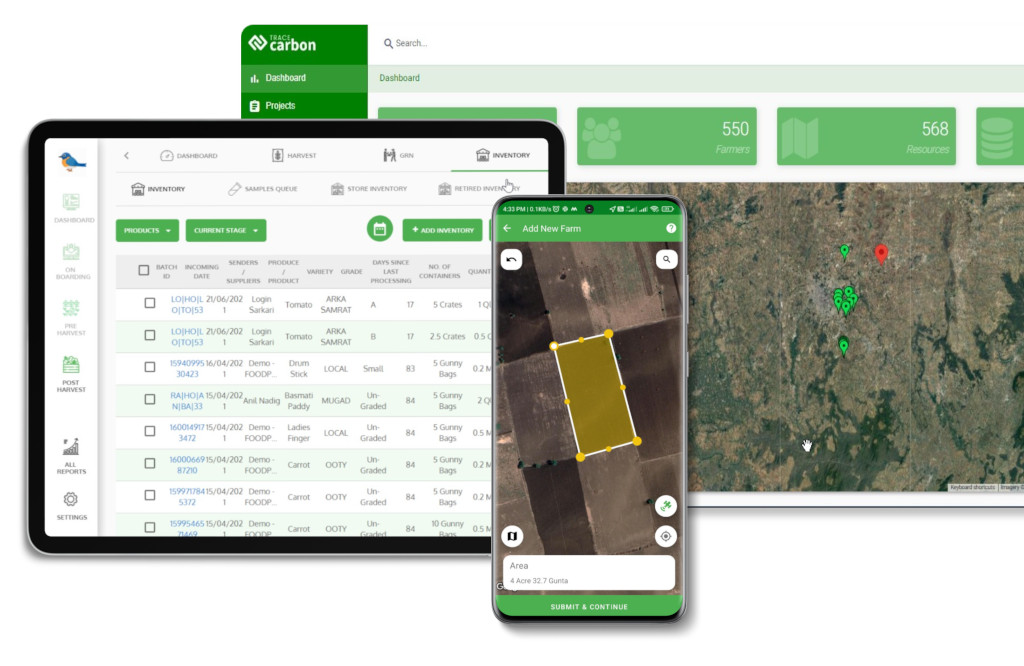Contact: +91 99725 24322 |
Menu
Menu
Quick summary: Discover the critical role of geolocation in meeting EUDR compliance. Learn how accurate geolocation data safeguards your business from penalties and enhances sustainability.

If you’re placing products like coffee, cocoa, palm oil, or rubber on the EU market, geolocation isn’t just helpful—it’s non-negotiable under the EU Deforestation Regulation (EUDR). To be compliant, your product must be traceable all the way back to the exact plot of land where it was produced. That means submitting accurate geolocation data—not just the region, not just the farm, but the actual point or polygon coordinates.
Most companies aren’t failing because they ignore compliance. They’re failing because they rely on incomplete, inconsistent, or outdated location data. And EUDR leaves no room for error. Whether you’re an importer, exporter, trader, or manufacturer, the question you must answer is:
Can you prove, with mapped coordinates, where every batch originated?
This guide will break down exactly what EUDR geolocation requirements mean, what format is acceptable, and how to avoid costly shipment delays or rejections due to simple data errors.
Key Takeaways
Under EUDR, you must know exactly where your raw materials were grown. Not vaguely. Not “somewhere in Ghana.” But exactly which plot, which coordinates, whose land. To prove that your products are deforestation-free, you’re required to provide geolocation data for every plot of land used to produce the commodity—this could be a point (a central coordinate) or a polygon (the boundary of the plot).
This data is then submitted as part of your Due Diligence Statement (DDS) in the EU’s TRACES system. Without it, your shipment can’t legally enter the EU.
If you’re the operator (usually the EU-based importer or first placer on the market), the responsibility is on you. Even if your supply chain involves multiple layers—like exporters, aggregators, or traders—the obligation to ensure this data is valid and traceable sits with the operator.
Many businesses rely on partners or field agents to gather this data from smallholder farmers, which introduces risk. If just one plot is undocumented or incorrectly mapped, your entire batch could be flagged or rejected.
Plot-level means you must pinpoint the exact farm plot where the commodity was grown—not just the village, district, or farm name. Think GPS coordinates: either a single point or a polygon outlining the field.
Technically, yes—for now. But the EU strongly recommends polygon data for full clarity, and audits may increasingly demand it. Points can be imprecise and risky for verifying deforestation status. Polygons protect your shipment and your reputation.
Yes, if they are part of your sourcing chain. Even if your supplier is a smallholder in a remote area, you are still required to provide geolocation of their land. The challenge is scale and digital access—but that’s exactly where tech solutions can help.
Here’s what most businesses get wrong: they assume geolocation is “just another field” in the form. It’s not. It’s the foundation of your entire compliance claim. It’s what links your shipment to real land, real production, and real legality.
And if that link breaks—because of bad data, an unmapped farm, or a reused point from a past batch—you don’t just risk a fine. You risk losing EU market access, damaging brand trust, and derailing your entire supply chain.
Digitally capturing plot data with GPS-enabled mobile apps, validating with satellite imagery, and integrating it into your DDS workflow is no longer optional—it’s urgent.
Platforms like TraceX automate this entire process: from smallholder onboarding to polygon validation, batch linkage, and one-click DDS generation.
A point is a single coordinate — like placing a pin in the center of a coffee farm.
It tells the EU: “This is roughly where the commodity was produced.” It’s fast, easy to collect with a phone, and better than nothing.
But here’s the problem: points don’t show scale, boundaries, or overlap, and that makes it nearly impossible to verify whether the land is truly deforestation-free — the whole point (pun intended) of the EUDR.
A polygon is a digital shape outlining the exact plot of land — usually with 3 or more coordinates connected to form a boundary.
This format shows how big the farm is, what’s inside, and what’s around it — allowing satellite systems to validate whether deforestation happened post-2020.
It’s more precise, audit-friendly, and defensible in case of inspections.
You’re an exporter sourcing cocoa from five farmers. You collect one GPS point per farm. When you submit your DDS, customs flags your shipment. Why?
Because one of those points sits near a protected forest zone — but without a polygon, there’s no way to prove whether the cocoa trees fall inside the forest boundary or just near it.
Now you’re in damage-control mode. Had you submitted a polygon, satellite verification would’ve cleared the shipment instantly.
So, Is a Point Enough for EUDR?
Technically, yes—for now. But let’s be real:
Auditors, customs, and regulators trust polygons. So do buyers who want proof that your “deforestation-free” claim holds water.
Your compliance shouldn’t hinge on a single point. It should be backed by boundaries.
Whether you’re an importer, exporter, or sourcing manager, here’s your goal:
Submit verifiable, batch-linked geolocation data that clears compliance—without manual back-and-forth.
That’s not just about checking a box. It’s about protecting your brand, your margins, and your EU market access.
Platforms like TraceX help you:
All in one place—no tech skills needed.
If your Due Diligence Statement (DDS) was flagged—or worse, rejected—it likely wasn’t because you didn’t submit something. It’s because what you submitted wasn’t accurate enough.
When it comes to EUDR, traceability isn’t symbolic—it’s spatial. If you can’t prove exactly where your product was grown with verifiable data, your entire batch is at risk.
Let’s talk about the most common (and costly) geolocation errors, and how they quietly derail even the most well-intentioned compliance teams.
You’d be surprised how many DDS submissions use warehouse addresses, nearby roads, or administrative village centers instead of the real farm plot. It may feel “close enough,” but to EU customs? It’s a red flag. They want plot-level proof, not regional guesses.
What breaks? You lose credibility with auditors and may fail satellite validation instantly.
In a rush to onboard suppliers, many teams copy and paste polygon data across multiple farmers or batches. But no two plots are the same. Recycled coordinates, reused shapes, or overlapping boundaries signal potential fraud—or sloppiness.
What happens? TRACES may reject your DDS, or worse—trigger a supply chain investigation.
Submitting an incomplete polygon—missing corners, broken shapes, or inaccurate acreage—makes it impossible to cross-check against deforestation data. If a shape can’t be verified by satellite, it won’t hold up in your DDS.
The risk? Your shipment gets held at customs until clarified—or denied outright.
Most companies don’t make these errors out of neglect. The truth is:
And none of it scales when you’re dealing with 100+ suppliers across multiple origin countries.
That’s exactly why geolocation needs tech-enabled automation—to reduce human error, standardize data formats, and create a verifiable audit trail from farm to port.
Submitting Your DDS? Don’t Let a Tiny GeoJSON Error Derail It.
One bad coordinate can cost you your EU shipment. Learn the most common GeoJSON file mistakes—like broken polygons, wrong formats, and invalid boundaries—and how to fix them fast.
Because your DDS is only as strong as the coordinates it’s built on.
Many businesses wrongly assume that geolocation is just about “dropping a pin.” But under the EU Deforestation Regulation (EUDR), it’s much more than that. It’s about proving—beyond doubt—that your product comes from a deforestation-free plot of land. And for that, accuracy is everything.
You want to submit a Due Diligence Statement (DDS) that clears customs, avoids audits, and builds trust. But your challenge? Coordinating hundreds of farms, field staff, and regions—some with no internet, tech, or standardized mapping.
So, how do you collect accurate geolocation data at scale—without chaos?
Equip field teams and suppliers with GPS-enabled mobile apps or handheld devices that can log accurate coordinates—even offline. Solutions like TraceX help capture:
Discover how a global tyre manufacturer used GeoJSON mapping and satellite validation to ensure EUDR compliance—without slowing down operations.
Don’t treat geolocation collection as a one-time event. Embed it into your supplier onboarding process, so every new producer:
Once geolocation data is collected, you must validate it for deforestation risk. Tech platforms like TraceX layer plot boundaries over:
This ensures you’re not just collecting data—you’re proving your supply is compliant and defensible.

Before you submit a DDS in TRACES, verify that your geolocation data:
With TraceX, you get an all-in-one platform that:
When it comes to EUDR compliance, geolocation data isn’t optional—it’s foundational. TraceX helps you avoid costly errors and rejections through a powerful, built-in validation system designed to meet EU regulatory standards.
Before a deforestation check even begins, we validate the integrity and structure of your GeoJSON file through a 13-point geometry assessment—ensuring your polygon boundaries are clean, accurate, and EUDR-ready.
What we check:
If the geometry fails

Only after the geometry is confirmed as valid, TraceX performs a deforestation risk analysis using two trusted, EU-accepted satellite datasets:
These allow us to:
If deforestation is detected
Why It Matters
This two-tiered approach ensures your Due Diligence Statements (DDS) are:
By catching errors early—before submission—you reduce:
In EUDR compliance, precision isn’t a luxury—it’s a requirement. One faulty polygon or unverified coordinate can derail your entire shipment, trigger audits, or even block access to the EU market. With TraceX, you don’t just collect geolocation data—you validate it, verify it, and confidently submit it. Don’t wait for a rejection to uncover a mapping error. Act now, stay compliant, and secure your market access—plot by plot.
Yes. Regardless of country risk level, all operators must provide geolocation (point or polygon) for the origin of commodities.
No. Plot-level geolocation must be collected and validated before submitting the Due Diligence Statement (DDS).
Use mobile-based data collection tools that allow field agents to capture accurate coordinates—even offline.
